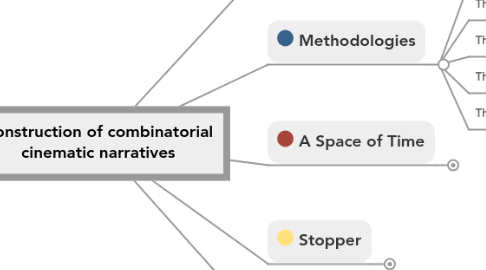
1. Methodologies
1.1. Chapters / Lexias / Modules
1.2. The linear approach
1.3. The branching approach
1.3.1. Print example
1.3.1.1. Choose your own adventure
1.3.1.1.1. Visualization
1.4. The database approach
1.4.1. Print example
1.4.1.1. Dictionary of Khazars
1.5. The reconstructive approach
1.5.1. Text
1.5.1.1. Exquisite corpse
1.5.2. Music
1.5.2.1. Mozart's Dice Game
1.5.3. Audiovisual media
1.5.3.1. Lev Manovich's Soft Cinema
2. Media, Storytelling, and (non)Linearity
2.1. Oral storytelling
2.2. Print media
2.2.1. Linearity and the Story Arch
2.3. Audiovisual media
2.3.1. Cinematic language
2.4. Computer media
2.4.1. Principles
2.4.1.1. Numerical
2.4.1.2. Modularity
2.4.1.3. Automation
2.4.1.4. Variability
2.4.1.5. Transcoding
3. A Space of Time
3.1. The database approach
3.2. The reconstructive approach
3.3. Conceptual breakthroughs
3.3.1. Same media two ways of presenting the story
3.3.2. Amount of media is important
3.3.2.1. More production
3.3.2.2. Lesser cost
3.3.3. Depth of story is important
3.3.4. Interaction between visual stimuli and auditory stimuli
3.4. Conclusion at this point
3.4.1. I see more possibilities in the reconstructive approach
3.4.2. Differentiate my work from video games
4. What is going on?
4.1. The editor's role
4.1.1. Timing of the elements in a narrative
4.1.1.1. A rigid control of the sequence delivers a well crafted meaning
4.1.1.2. A variable control of the sequence delivers multiple meanings
4.1.2. A visual metaphor
4.2. The creative process
4.3. The future of storytelling
4.3.1. Depth, drilling down multiple stories
5. Stopper
5.1. The reconstructive approach
5.1.1. Storytelling
5.1.1.1. No dialogue, only cinematic language
5.1.1.2. Two stories converging
5.1.1.3. Two stories mashed with audio
5.1.1.4. Time in the plot
5.1.1.5. Variable time for the experience
5.1.2. Production
5.1.2.1. Film Production
5.1.2.1.1. Cinematography
5.1.2.1.2. Sound production
5.1.2.1.3. Shooting
5.1.2.2. Post-production
5.1.2.2.1. Programming
5.1.2.2.2. Decomposition of the automated editing process
5.1.2.2.3. Tagging the narrative elements
5.1.2.2.4. Variations based on semantics
5.1.2.2.5. Decomposition of the media assets in the editing process.
5.1.3. Commercial aspects
5.1.3.1. Variable length
5.1.3.2. Modularity and advertising
5.2. The open source approach
5.2.1. Attribution
5.2.2. Non-commercial
